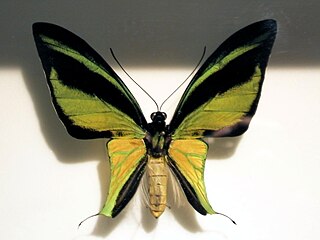
The savanna hawk is a large raptor found in open savanna and swamp edges. It was formerly placed in the genus Heterospizias. It breeds from Panama and Trinidad south to Bolivia, Uruguay and central Argentina.

Ornithoptera meridionalis, the southern tailed birdwing, is the smallest species of the genus Ornithoptera. It is known from a handful of localities in southeast Papua, New Guinea and several localities along the south coast of Irian Jaya.
The Isla De La Juventud tree hutia or southern hutia is a species of rodent in the family Capromyidae. It is endemic to lowland moist forests on Cuba's Isla de la Juventud. It is threatened by habitat loss.

The southern woolly lemur, or southern avahi, has been recently recognized as a separate species of woolly lemur in 2006 by Zaramody et al. It is a nocturnal and pair-living species. Groups can range from 2 to 5 individuals. A study in Sainte Luce forest revealed home range varied from 2.2 to 3.5 ha and that males can have larger home range and cover longer daily distances than females, in agreement with the territory defence and mate guarding hypotheses.

Psilocybe meridionalis is a psychedelic mushroom which has psilocybin and psilocin as main active compounds. This mushroom is closely related to Psilocybe stuntzii but can be distinguished by its smaller spores and the presence of pleurocystidia. This is the only species of Psilocybe from section Stuntzii which has been found in Mexico. It is known only from the type location in Neverias, Sierra de Cacoma, Jalisco, Mexico.
The Chatham kaka or Chatham Island kaka is an extinct parrot species previously found on the Chatham Islands, New Zealand. The first individuals were thought to belong to the kaka, but detailed examination of the subfossil bones showed that they actually belong to a separate endemic species. The species became extinct within the first 150 years of the arrival of the Polynesians around 1550, long before any European settlers. No skins or descriptions are available.
Ptericoptus is a genus of beetles in the family Cerambycidae, containing the following species:
Ptericoptus borealis is a species of beetle in the family Cerambycidae. It was described by Breuning in 1939. It is known from Mexico.
Ptericoptus intermedius is a species of beetle in the family Cerambycidae. It was described by Breuning in 1939. It is known from Mexico.
Ptericoptus similis is a species of beetle in the family Cerambycidae. It was described by Breuning in 1939. It is known from Colombia and Venezuela.
Ptericoptus sinuatus is a species of beetle in the family Cerambycidae. It was described by Breuning in 1939. It is known from Colombia and Peru.
Ptericoptus acuminatus is a species of beetle in the family Cerambycidae. It was described by Johan Christian Fabricius in 1801. It is known from Argentina, Brazil and Paraguay.
Ptericoptus avanyae is a species of beetle in the family Cerambycidae. It was described by Martins and Galileo in 2010. It is known from Brazil.
Ptericoptus caudalis is a species of beetle in the family Cerambycidae. It was described by Bates in 1880. It is known from Guatemala, Honduras, and Mexico.
Ptericoptus clavicornis is a species of beetle in the family Cerambycidae. It was described by Johan Christian Fabricius in 1801. It is known from Guyana and French Guiana.
Ptericoptus columbianus is a species of beetle in the family Cerambycidae. It was described by Breuning in 1950. It is known from Colombia.
Ptericoptus corumbaensis is a species of beetle in the family Cerambycidae. It was described by Galileo and Martins in 2003. It is known from Brazil.
Ptericoptus dorsalis is a species of beetle in the family Cerambycidae. It was described by Audinet-Serville in 1835. It is known from Brazil.
Ptericoptus griseolus is a species of beetle in the family Cerambycidae. It was described by Bates in 1880. It is known from Guatemala.
Ptericoptus panamensis is a species of beetle in the family Cerambycidae. It was described by Bates in 1880. It is known from Panama.






